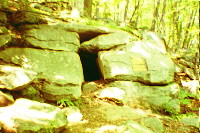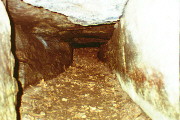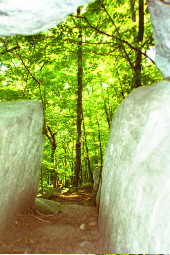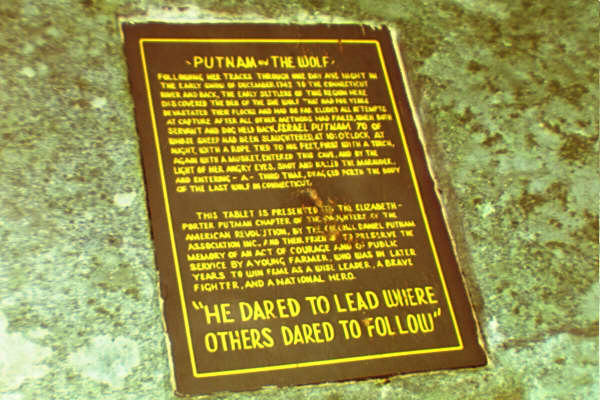


The whole day was spent by Putnam and his neighbours in attempting to dislodge the animal, but the dogs - one of them Putnam's own hound - which were sent into the den returned frightened and badly wounded and would not go in again. Straw and sulfer were burned within the entrance, but without compelling the wolf to quit her hiding place. Twelve unsuccessful hours passed away. It was already ten o'clock at night, yet Putnam felt the importance of continuing the efforts in the emergency. His servent being unwilling to enter the den and attempt to shoot the wolf, Putnam himself, notwithstanding the remonstrances of his neighbours against so perilous a venture, made ready to undertake it.
He took off his coat and waistcoat; then he tied a long rope around his legs in order that he could be pulled back by it when he kicked it as a signal; he lighted the torch which he had improvised from some strips of birch bark and, holding it in his hand, crawled into the cave. The entrance was about two feet square and very slippery on account of the ice. The den descended obliquely fifteen feet, then ran horizontally about ten feet more and ascended gradually sixteen feet to the end of the opening. It was not more than a yard wide in any part and it was so low overhead that in no place could a person raise himself from his hands and knees.

Crawling slowly down to the level part and continuing until he reached the gradual ascent, Putnam saw the fiery eyes of the wolf as she crouched at the end of the dark cave, gnashing her teeth and growling at him. He gave the signal which he had arranged, but the excited people, hearing the savage sound and thinking that he had been attacked, dragged him out with such solicitous but ill-judged energy that his shirt was stripped over his head and his skin severly scratched. He prepared himself to enter again, this time taking his gun, which he had loaded with nine buckshot. Holding it in one hand and a torch in the other, he advanced farther than before into the den and found the wolf even fiercer, howling, rolling her eyes, snapping her teeth, and dropping her head between her legs. He fired at her just as she was evidently about to spring upon him. Being instantly pulled out, he refreshed himself and waited for the smoke to disappear out of the den. He then made a third venture. When he approached the wolf this time he heard nothing from her and touching her nose with his torch, found that she was dead. He grasped her ears, kicked the rope and was drawn out, dragging his victim into the presence of the astonished and exultant people.

Up the ragged and icy face of the hill and through the wild woodland the wolf was carried to a house a mile distant and suspended from a beam into which an iron spike had been driven. Then at that midnight hour a sort of "wolf jubilee" was held and, for several succeeding days, people came from different directions to see the animal.

The exploit won at once for Putnam a local reputation for great bravery. Afterwards, when he became famous as a hero in the French and Indian War and the American Revolution, the story of the wolf hunt was universally told to illustrate his characteristic daring, and it gave him the sobriquet of "Old Wolf Putnam" during his military career.

FOLLOWING HER TRACKS THROUGH ONE DAY AND NIGHT IN THE EARLY SNOW OF DECEMBER 1742 TO THE CONNECTICUT RIVER AND BACK, THE EARLY SETTLERS OF THIS REGION HERE DISCOVERED THE DEN OF THE SHE WOLF THAT HAD FOR YEARS DEVASTED THEIR FLOCKS AND HAD SO FAR ELUDED ALL ATTEMPTS AT CAPTURE AFTER ALL OTHER METHODS HAD FAILED. WHEN BOTH SERVANT AND DOG HELD BACK. ISRAEL PUTNAM, OF WHOSE SHEEP HAD BEEN SLAUGHTERED, AT 10 O'CLOCK AT NIGHT, WITH A ROPE TIED TO HIS FEET, FIRST WITH A TORCH, AGAIN WITH A MUSKET, ENTERED THIS CAVE, AND BY THE LIGHT OF HER ANGRY EYES, SHOT AND KILLED THE MARAUDER, AND ENTERING - A THIRD TIME, DRAGGED FORTH THE BODY OF THE LAST WOLF IN CONNECTICUT.
THIS TABLET IS PRESENTED TO THE ELIZABETH-PORTER PUTNAM CHAPTER OF THE DAUGHTERS OF THE AMERICAN REVOLUTION, BY COLONEL DANIEL PUTNAM ASSOCIATION INC., AND THEIR FRIENDS TO PERSERVE THE MEMORY OF AN ACT OF COURAGE AND OF PUBLIC SERVICE BY A YOUNG FARMER, WHO WAS IN LATER YEARS TO WIN FAME AS A WISE LEADER, A BRAVE FIGHTER, AND A NATIONAL HERO.
"HE DARED TO LEAD WHERE OTHERS DARED TO FOLLOW"